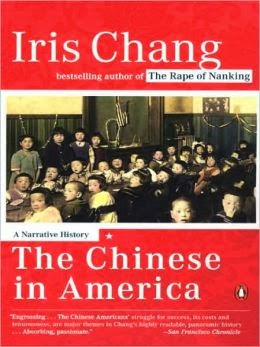By Jeff Burns
Happy Chinese New Year! Gong Xi Fa Cai!
The Year of the Horse is here.
Celebrate by reading some Chinese and Chinese-American history.
Unfortunately, the world lost author
Iris Chang much too early. She was the
author of two excellent books I highly recommend: The Rape of Nanking and The Chinese
in America: a Narrative History. The Rape of Nanking is a disturbing
but necessary account of the Japanese occupation of China in the 1930s,
particularly the atrocities committed in the city of Nanking. Japanese troops systematically ransacked the
city and brutally murdered more than 300,000 Chinese civilians. Unbelievably, the story’s full scope
was not very well known in the West
until Chang’s book, and the incident is still a source of tension in
Sino-Japanese relations today, with some Japanese still denying that it
happened.
The Chinese in America covers
the entire history of Chinese immigration to the US, beginning with the first
Chinese laborers who came for the California gold rush and stayed on to work on
the railroads and build communities here to the present day. She covers the whole experience, including
the nativist backlash, the effects of the communist-nationalist conflict in
America, and the wave of immigration that followed the Revolution.
On Gold Mountain by Lisa See
focuses on the gold rush experience. In
China, those who went to California were said to have “gone to Gold
Mountain.” She personalizes the story by
making it a family history, supported by years of research, sort of like a
Chinese –American version of Roots.
She succeeds in making the story universal and enthralling.
 Coolies
and Cane: Race, Labor, and Sugar in the Age of Emancipation by
Moon-Ho Jung is not quite as entertaining since it’s more academic in tone, but
it introduced me to a fascinating aspect of southern history that I had never
known about. During Reconstruction,
southern landowners needed labor to replace slavery; as a result,
sharecropping, basically a new face of slavery, developed. Some planters came
up with an innovative idea: encourage
Chinese immigrants to move to the South. Many Chinese seized the opportunity
and moved to the Deep South, creating a very unique situation. In the racially charged atmosphere of the Jim
Crow world, these new arrivals were neither black nor white, and they found
themselves suspended between the two worlds in many ways. The book is about that unusual situation and
the contradictions that were highlighted by the experiment and its effects on
both the Chinese and on the South itself.
Coolies
and Cane: Race, Labor, and Sugar in the Age of Emancipation by
Moon-Ho Jung is not quite as entertaining since it’s more academic in tone, but
it introduced me to a fascinating aspect of southern history that I had never
known about. During Reconstruction,
southern landowners needed labor to replace slavery; as a result,
sharecropping, basically a new face of slavery, developed. Some planters came
up with an innovative idea: encourage
Chinese immigrants to move to the South. Many Chinese seized the opportunity
and moved to the Deep South, creating a very unique situation. In the racially charged atmosphere of the Jim
Crow world, these new arrivals were neither black nor white, and they found
themselves suspended between the two worlds in many ways. The book is about that unusual situation and
the contradictions that were highlighted by the experiment and its effects on
both the Chinese and on the South itself. 



No comments:
Post a Comment